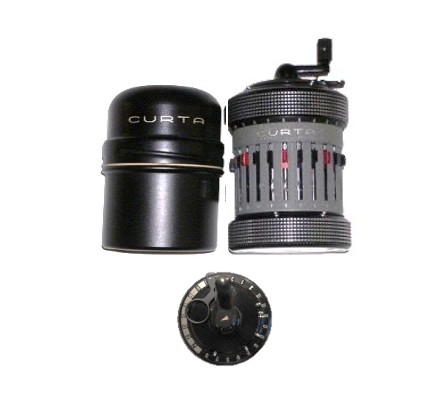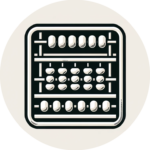CURTA model 2, 1938
Inventor
Curt HERZSTARK (Germany)
Invention date
1938
Manufacturing date:
Between 1948-1972 (N° 166620233)
Manufacturing location
Mauren – Liechtenstein
Manufacturer
CONTINA
Dimensions
D 6 H 10
Reference Number
277

History and Functionality
Curt HERSZSTARK (1902-1988) conceived his calculating tool during his imprisonment in the Buchenwald concentration camp. After the war, he created a new “design”: the CURTA, which gave rise to two functionally identical models that have different capacities (8-digit and 11). The CURTA uses the principle of the stepped-drum mechanism (invention of LEIBNIZ), but HERSZSTARK had the idea to use a single cylinder for all digits while other machines require one cylinder for each digit.
This option significantly reduces the volume of the machine and its weight. Designed in a cylindrical shape, it fits easily in your hands and is easily transportable. The CURTA machine comes with a cylindrical metal box protecting it from physical damage.
This is a high precision machine composed of 600 parts which has safety locks to prevent incorrect maneuvers. This machine is noiseless and requires minimal physical effort unlike earlier machines. Some internal parts are protected against oxidation.
It weighs only 230g compared to a 6kg machine of the same time using a different technology. The mechanism cannot be worn out because of the low number of moving parts. Building a high performance mechanism of such reduced dimensions requires utmost precision in manufacturing. All parts are subject to strict quality control.
The setting mechanism is on the body of the machine and the result mechanism is located on the upper part of the instrument.
This result mechanism can rotate around its axis to make the shifts required for specific operations similarly to the movable carriage of the X. THOMAS of COLMAR arithmometer machines.
The CURTA enables the four operations. It deals with multiplication and division by repeating additions and subtractions. An addition is simply performed by setting the number by sliding the longitudinal sliders and then turning the crank. To add a number, one should set the new number on the setting mechanism and then turn the crank once. In the case of multiplication, additions should be repeated and the result mechanism should be rotated.
The CURTA had a wide number of uses. It was widely used in commerce and industry to calculate percentages, prorate costs, and calculate exchange rates. Its power enables effective extraction of square roots by implementing an approached algorithm.
This machine enjoyed real commercial success and is extremely ingenious. It was manufactured from 1948 to 1972. During these years 140,000 machines were produced.
About The Inventor
Curt Herzstark (1902-1988) was an Austrian engineer and inventor, renowned for his creation of the CURTA, one of the most innovative mechanical calculators of the 20th century. Herzstark’s life and career were as intricate and compelling as the device he created, marked by brilliance, adversity, and resilience.
Born in Vienna, Herzstark was the son of a well-respected owner of a calculating machine factory. Growing up in an environment filled with mechanical devices and engineering challenges, Herzstark showed an early interest and aptitude in mechanics and mathematics. His father’s company, Herzstark & Co., provided him with the perfect training ground, where he honed his skills and deepened his understanding of mechanical calculators. His work during this period laid the foundation for his later masterpiece, the CURTA.
Herzstark’s life took a dramatic turn during World War II. Due to his Jewish heritage, he was arrested in 1943 and sent to the Buchenwald concentration camp. Despite the harsh conditions, Herzstark continued to pursue his passion for engineering. He conceived the design of the CURTA while in captivity, envisioning a compact calculator that could fit in the palm of a hand. This vision was a radical departure from the bulky calculating machines of that era.
The CURTA, often referred to as a “pepper grinder” due to its unique shape and size, was Herzstark’s crowning achievement. After the war, he was liberated from Buchenwald and wasted no time in bringing his vision to reality. The CURTA’s design was revolutionary, featuring a step drum mechanism that allowed for quick and precise calculations. It was capable of performing addition, subtraction, multiplication, division, and more complex calculations like square roots.
The CURTA gained widespread acclaim and was used globally by scientists, engineers, and mathematicians until the advent of electronic calculators in the 1970s.
Today, Curt Herzstark is remembered not only as the inventor of the CURTA but also as a symbol of the enduring human spirit in the face of challenges.

